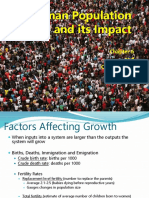0 ratings0% found this document useful (0 votes)
59 viewsDemographic Transition Model: Stage 1 Stage 2 Stage 3 Stage 4 Stage 5
Demographic Transition Model: Stage 1 Stage 2 Stage 3 Stage 4 Stage 5
Uploaded by
api-240746852The Demographic Transition Model describes 5 stages of population growth based on birth and death rates as countries develop economically and socially. Stage 1 has high birth and death rates with low population growth. Stage 2 sees death rates fall while birth rates remain high, leading to rapid population increase. Stages 3 and 4 experience declining birth rates and increasing life expectancy, resulting in slower growth. Stage 5 is characterized by low birth and death rates and stable population.
Copyright:
© All Rights Reserved
Available Formats
Download as PDF, TXT or read online from Scribd
Demographic Transition Model: Stage 1 Stage 2 Stage 3 Stage 4 Stage 5
Demographic Transition Model: Stage 1 Stage 2 Stage 3 Stage 4 Stage 5
Uploaded by
api-2407468520 ratings0% found this document useful (0 votes)
59 views1 pageThe Demographic Transition Model describes 5 stages of population growth based on birth and death rates as countries develop economically and socially. Stage 1 has high birth and death rates with low population growth. Stage 2 sees death rates fall while birth rates remain high, leading to rapid population increase. Stages 3 and 4 experience declining birth rates and increasing life expectancy, resulting in slower growth. Stage 5 is characterized by low birth and death rates and stable population.
Original Title
Untitled
Copyright
© © All Rights Reserved
Available Formats
PDF, TXT or read online from Scribd
Share this document
Did you find this document useful?
Is this content inappropriate?
The Demographic Transition Model describes 5 stages of population growth based on birth and death rates as countries develop economically and socially. Stage 1 has high birth and death rates with low population growth. Stage 2 sees death rates fall while birth rates remain high, leading to rapid population increase. Stages 3 and 4 experience declining birth rates and increasing life expectancy, resulting in slower growth. Stage 5 is characterized by low birth and death rates and stable population.
Copyright:
© All Rights Reserved
Available Formats
Download as PDF, TXT or read online from Scribd
Download as pdf or txt
0 ratings0% found this document useful (0 votes)
59 views1 pageDemographic Transition Model: Stage 1 Stage 2 Stage 3 Stage 4 Stage 5
Demographic Transition Model: Stage 1 Stage 2 Stage 3 Stage 4 Stage 5
Uploaded by
api-240746852The Demographic Transition Model describes 5 stages of population growth based on birth and death rates as countries develop economically and socially. Stage 1 has high birth and death rates with low population growth. Stage 2 sees death rates fall while birth rates remain high, leading to rapid population increase. Stages 3 and 4 experience declining birth rates and increasing life expectancy, resulting in slower growth. Stage 5 is characterized by low birth and death rates and stable population.
Copyright:
© All Rights Reserved
Available Formats
Download as PDF, TXT or read online from Scribd
Download as pdf or txt
You are on page 1of 1
Demographic Transition Model
Stage 1 Stage 2 Stage 3 Stage 4 Stage 5
Name of Stage:
Birth rate high or low?
Death rate high or low?
Population Growth:
Life Expectancy:
Description of the transition:
This transition occurs as a
result of
Countries currently at this
stage:
What do the population
pyramids look like at each
stage of the Demographic
Transition Model?
You might also like
- In What Year Does The Transition Stages StartedDocument6 pagesIn What Year Does The Transition Stages StartedNavasca Jhey Ann100% (1)
- Presentation1 - Global DemographyDocument17 pagesPresentation1 - Global Demographyclara dupitas86% (7)
- Ap Hgeo ch2 Key Issue Reading GuideDocument10 pagesAp Hgeo ch2 Key Issue Reading Guideapi-41164603100% (1)
- Charles P. Allen High School: Section A: Short Answer Question (6 Marks)Document1 pageCharles P. Allen High School: Section A: Short Answer Question (6 Marks)api-240746852No ratings yet
- 4 - DTM Animation (Old)Document4 pages4 - DTM Animation (Old)Adam ProctorNo ratings yet
- The Demographic Transition ModelDocument6 pagesThe Demographic Transition ModelRachelle DalingNo ratings yet
- AP HuG Demographic Transition Model AnalysisDocument2 pagesAP HuG Demographic Transition Model AnalysisjadelineNo ratings yet
- Lesson 5 - The Demographic Transition ModelDocument11 pagesLesson 5 - The Demographic Transition Modelkim.durNo ratings yet
- AS Module 2 The Demographic Transition ModelDocument10 pagesAS Module 2 The Demographic Transition ModelBaba ButtNo ratings yet
- Demographic Transition ModelDocument18 pagesDemographic Transition ModelYvonne Sorviel SiiloNo ratings yet
- Demographic Transition TheoryDocument7 pagesDemographic Transition Theorymajnumr919No ratings yet
- DTM HandoutDocument2 pagesDTM Handoutq6dc466k8bNo ratings yet
- Demography Demographic: Cycle AND TransitionDocument28 pagesDemography Demographic: Cycle AND TransitionREVATHI MAROJUNo ratings yet
- Group 3 - Global DemographyDocument57 pagesGroup 3 - Global DemographywhpyrtdmygNo ratings yet
- Lecture 3Document28 pagesLecture 3gmpq4cjnfdNo ratings yet
- EC ONT Emporary W ORL D: Global DemographyDocument35 pagesEC ONT Emporary W ORL D: Global DemographyArrent Chrislyn ReyesNo ratings yet
- What Are The Stages of The Demographic Transition Model?Document2 pagesWhat Are The Stages of The Demographic Transition Model?dibellamariachiara.06No ratings yet
- Demographic Transition and Its Relation To NCDDocument35 pagesDemographic Transition and Its Relation To NCDAlmasNo ratings yet
- Demographic Transition PPT Best OneDocument27 pagesDemographic Transition PPT Best OneMohammadFaisalQureshiNo ratings yet
- Geography Grade 10 Term 3 Week 2Document6 pagesGeography Grade 10 Term 3 Week 2Ridivhe FhedzisaniNo ratings yet
- Demography Unit O1Document26 pagesDemography Unit O1alihamzaab1454No ratings yet
- The Human Population and Its ImpactDocument45 pagesThe Human Population and Its ImpactMark ChouNo ratings yet
- The Human Population and Its ImpactDocument40 pagesThe Human Population and Its ImpactMark ChouNo ratings yet
- Demographic Transition Model Video and LessonDocument3 pagesDemographic Transition Model Video and Lessonapi-488898477No ratings yet
- 05c Population Pyramids ATRDocument28 pages05c Population Pyramids ATRqf2yhvwp4kNo ratings yet
- DEMOGRAPHYDocument4 pagesDEMOGRAPHYalolodjonyNo ratings yet
- Week 13Document45 pagesWeek 13Kai NoborikawaNo ratings yet
- Population Ppt2Document22 pagesPopulation Ppt2Mary Ann MaherNo ratings yet
- The Human Population and Its ImpactDocument39 pagesThe Human Population and Its ImpactMark ChouNo ratings yet
- 01 DevII - Chapter OneDocument34 pages01 DevII - Chapter OneTaju MohammedNo ratings yet
- GE104Document12 pagesGE104Bunyi, Lyra Kate R.No ratings yet
- Transition ModelDocument2 pagesTransition Modelexlofister20No ratings yet
- DMT & Population Pyramid WorksheetDocument4 pagesDMT & Population Pyramid WorksheetElyse GarciaNo ratings yet
- Global Demography CompressesDocument6 pagesGlobal Demography CompressesDianneNo ratings yet
- Lecture 6- Human Populationand Its ImpactsDocument41 pagesLecture 6- Human Populationand Its ImpactsGrace KaranjaNo ratings yet
- Worlds Population: Chapter 6: Population Growth and Economic DevelopmentDocument10 pagesWorlds Population: Chapter 6: Population Growth and Economic DevelopmentKeYPop FangirlNo ratings yet
- Introduction To Demography: DR L. Kalilani-Phiri Public Health Department Division of Community HealthDocument55 pagesIntroduction To Demography: DR L. Kalilani-Phiri Public Health Department Division of Community HealthrutendonormamapurisaNo ratings yet
- Population and Demography: Salwana Shamaun Nursing InstructorDocument24 pagesPopulation and Demography: Salwana Shamaun Nursing InstructorHina AslamNo ratings yet
- Global Demography: Professor: Dr. Rena V. Tejada Adapted:Mr - Don SislesDocument15 pagesGlobal Demography: Professor: Dr. Rena V. Tejada Adapted:Mr - Don SislesNikki MeeNo ratings yet
- Theory of Demographic TransitionDocument9 pagesTheory of Demographic TransitionJessel IbrahimNo ratings yet
- Human Population UpdatedDocument46 pagesHuman Population UpdatedKenneth Pimentel100% (1)
- Demography Transition August 21-2c 2017Document40 pagesDemography Transition August 21-2c 2017Sonia khanNo ratings yet
- Module 5 Global Population and MobilityDocument1 pageModule 5 Global Population and Mobilitywyndel malangNo ratings yet
- Lecture 5 Haneen FrehatDocument20 pagesLecture 5 Haneen FrehatLeenRawashdeh09No ratings yet
- Lecture12 SociologyDocument15 pagesLecture12 SociologyZaigham KhanNo ratings yet
- Global Demography MigrationDocument62 pagesGlobal Demography MigrationIrene VillasNo ratings yet
- Population Growth, Sustainable DevelopmentDocument16 pagesPopulation Growth, Sustainable DevelopmentNituNo ratings yet
- The Human Population and Its ImpactDocument44 pagesThe Human Population and Its ImpactMark ChouNo ratings yet
- Lecture 5Document27 pagesLecture 5Hamna IftikharNo ratings yet
- 2 The DTMDocument11 pages2 The DTMapi-336814146No ratings yet
- Demographic Transition Model 2Document12 pagesDemographic Transition Model 2muhammad.faisal.ghulam.mustafa37No ratings yet
- p20 578 PDFDocument12 pagesp20 578 PDFClement LimNo ratings yet
- Lesson 11 Ge3Document3 pagesLesson 11 Ge3DHAPNY GRACE ESCORRONo ratings yet
- DEMOGRAPHICS ASSIGNMENT - 3Document3 pagesDEMOGRAPHICS ASSIGNMENT - 3prashanthi.rsNo ratings yet
- PEED All GovernanceDocument439 pagesPEED All GovernanceGetuNo ratings yet
- Population PyramidsDocument16 pagesPopulation Pyramidsjodiecrimp88No ratings yet
- Demography/Global Health & Health TransitionDocument22 pagesDemography/Global Health & Health TransitionSHAFIQNo ratings yet
- ESS Grade 11 8.1 Human Population Dynamics Lesson 3Document17 pagesESS Grade 11 8.1 Human Population Dynamics Lesson 3Japora ChigabatiaNo ratings yet
- Chapter 2 Population and Health Key IssuesDocument10 pagesChapter 2 Population and Health Key Issuesmahuli124No ratings yet
- I PopulationDocument10 pagesI PopulationAshutosh DevkotaNo ratings yet
- APES REVIEW - CompleteDocument6 pagesAPES REVIEW - CompleteClaire AncellNo ratings yet
- New World Order!?!Document15 pagesNew World Order!?!api-240746852No ratings yet
- North American DefenceDocument11 pagesNorth American Defenceapi-240746852No ratings yet
- Cold War ConfrontationsDocument10 pagesCold War Confrontationsapi-240746852No ratings yet
- What It Is and How It WorksDocument8 pagesWhat It Is and How It Worksapi-240746852No ratings yet
- Term Project 2013-2014: Urbanization Photo EssayDocument1 pageTerm Project 2013-2014: Urbanization Photo Essayapi-240746852No ratings yet
- Charles P. Allen High School: 2013-2014 Semester Two Global Geography 12 Final Exam PreviewDocument1 pageCharles P. Allen High School: 2013-2014 Semester Two Global Geography 12 Final Exam Previewapi-240746852No ratings yet
- Global Geography 12 C.P. Allen High School Global Geography 12 Independent Study SeminarsDocument2 pagesGlobal Geography 12 C.P. Allen High School Global Geography 12 Independent Study Seminarsapi-240746852No ratings yet
- Canadian History XIDocument22 pagesCanadian History XIapi-240746852No ratings yet
- Canada and The Cold WarDocument9 pagesCanada and The Cold Warapi-240746852No ratings yet
- Global Geography 12 C.P. Allen High School: Six Concepts of GeographyDocument1 pageGlobal Geography 12 C.P. Allen High School: Six Concepts of Geographyapi-240746852No ratings yet
- Chapter Five Questions Canada's Role in World War II: Part One: Answer The FollowingDocument1 pageChapter Five Questions Canada's Role in World War II: Part One: Answer The Followingapi-240746852No ratings yet
- Population ProblemsDocument14 pagesPopulation Problemsapi-240746852No ratings yet
- UntitledDocument48 pagesUntitledapi-240746852No ratings yet
- Resource Case Study Comparison In-Class Assignment: Types Issue SolutionsDocument2 pagesResource Case Study Comparison In-Class Assignment: Types Issue Solutionsapi-240746852No ratings yet
- Global Geography 12 C.P. Allen High School Pollution WebquestDocument1 pageGlobal Geography 12 C.P. Allen High School Pollution Webquestapi-240746852No ratings yet
- Cold War Seminars: Canadian History 11Document2 pagesCold War Seminars: Canadian History 11api-240746852No ratings yet
- Six Factors Leading To ConfederationDocument17 pagesSix Factors Leading To Confederationapi-240746852No ratings yet
- Document Analysis - Opvl: OriginDocument2 pagesDocument Analysis - Opvl: Originapi-240746852No ratings yet
- Global Geography 12 C.P. Allen High School: GGS 12 Map Assignments and QuizzesDocument2 pagesGlobal Geography 12 C.P. Allen High School: GGS 12 Map Assignments and Quizzesapi-240746852No ratings yet
- Global Geography 12 C.P. Allen High SchoolDocument1 pageGlobal Geography 12 C.P. Allen High Schoolapi-240746852No ratings yet
- Global Geography 12 C.P. Allen High School: Group Challenge!Document4 pagesGlobal Geography 12 C.P. Allen High School: Group Challenge!api-240746852No ratings yet
- The American RevolutionDocument17 pagesThe American Revolutionapi-240746852No ratings yet
- Rebellions of 1837: Upper and Lower Canada: Textbook Q&A Pages 159-161Document1 pageRebellions of 1837: Upper and Lower Canada: Textbook Q&A Pages 159-161api-240746852No ratings yet
- Charles P. Allen High School: Student Population Census AssignmentDocument1 pageCharles P. Allen High School: Student Population Census Assignmentapi-240746852No ratings yet
- Introduction To DemographyDocument8 pagesIntroduction To Demographyapi-240746852No ratings yet
- The War of 1812: Canadian History 11Document35 pagesThe War of 1812: Canadian History 11api-240746852No ratings yet
- Infectious Diseases & Natural DisastersDocument22 pagesInfectious Diseases & Natural Disastersapi-240746852No ratings yet
- BiodiversityDocument20 pagesBiodiversityapi-240746852No ratings yet
- The Royal Proclamation (1763)Document8 pagesThe Royal Proclamation (1763)api-240746852No ratings yet

























































































